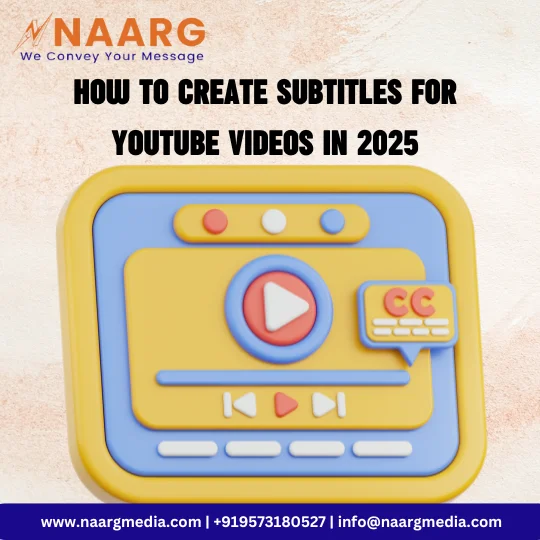You are just starting your YouTube career. You are all set, and your content is ready. Even the video has been shot; you just need to upload it. But wait! Have you added subtitles to your video?
Subtitles in your videos help you more than you may think. Subtitles have traditionally made content accessible for viewers who are deaf, hard of hearing, or speak a different language.
However, in today’s digital landscape, they’ve become a valuable tool for improving viewer engagement, enhancing comprehension, and reaching broader global audiences.
But the question here arises: how to create subtitles for YouTube videos?
Don’t worry!
We will walk you through the process of how to create subtitles for YouTube Videos that enhance comprehension and visibility.

Why do Subtitles Matter for YouTube Videos?
Did you know that according to recent statistics, it was believed that 80% of people subtitle when they watch a video? Nowadays, subtitles are considered a game-changer for YouTube videos.
As they enhance accessibility and boost engagement. Subtitles in a video make content inclusive for viewers with hearing impairments and cater to non-native speakers, thus expanding the potential audience across language barriers.
They also play a crucial role in improving viewer retention, allowing people to follow along even in noisy environments or when watching without sound. They also enhance SEO by making videos more searchable, as YouTube can index the text, improving discoverability.
We are living in a world where the attention span is getting shorter with each passing day; subtitles can keep viewers hooked and coming back for more.
Why are Subtitles Important for Global Audiences?
Subtitles are essential to reach global audiences, as they bridge the gap between two languages and also open up diverse content for a diverse range of viewers.
Take, for example, the South Korean movie Parasite, which took the world by storm and even won the Academy Award for Best Picture in 2020. Why do you think that this movie was such a hit?
Because of the power of subtitles, that allowed non-Korean-speaking audiences to fully grasp the story’s depth. With the help of subtitles, these movies achieve international fame, making the stories accessible to viewers worldwide.
Subtitles and closed captions transform local hits into global sensations by enabling cultural exchange and ensuring that language is no longer a barrier to enjoying great content.
How to create Subtitles for YouTube videos?
To enhance accessibility and improve audience engagement, it is best advised to create subtitles for YouTube videos. So, to help you understand better, we have listed a step-by-step guide to help you create subtitles for YouTube videos.
1. Use YouTube’s Auto-Generated Subtitles
YouTube has a feature that offers automatic subtitle icons, making it easier to create closed captions with minimal effort.
You just need to upload your video on YouTube, then go to YouTube Studio, then select Subtitles from the menu, and choose the video you want to add subtitles to.
Then YouTube will automatically auto-generate subtitles for your video. This auto-generated subtitles feature is useful for quick subtitle creation.
But you need to double-check the auto-generated captions as they may contain errors, especially in terms of punctuation or specialized terminology.
2. Create Subtitles Manually in YouTube Studio
Now if you want more control over the accuracy and timing of the subtitles, then creating subtitles manually is an effective option. In YouTube Studio, go to Subtitles and select your video.
Then click Add Language, furthermore choose your preferred language, and select Add under the subtitles section.
Finally, manually type the subtitles by entering text in the provided boxes and adjusting the timing to sync with the audio. This manual method is precise, but it may take more time, especially for longer videos.
3. Upload a Subtitle File
In this method, if you already have a subtitle file like an SRT, VTT, or SBV file, you can easily upload it to YouTube.
The process is simple; you just need to go to Subtitles in YouTube Studio and choose the video. Then click on Add under the subtitles section and select Upload File.
Next, choose whether you have a file with timing or without, and then upload the file. This uploading of subtitle files is efficient for professionals who have pre-prepared subtitles, ensuring accuracy and saving time.
4. Use Subtitle Creation Software
There is also a way to create subtitles using third-party software like Aegisub or Subtitle Edit.
All this software allows you to create more complex subtitle files with features like customizable fonts, colors, and syncing controls.
Subtitle creation software provides enhanced features for detailed customization and is perfect if you need advanced styling or work with multiple subtitle files.
5. Translate Subtitles for Global Audiences
Once the subtitles are created in one language, YouTube allows you to add translated subtitles in other languages for global viewers.
This particular feature helps extend your video’s reach, thus making it accessible to non-native speakers and increasing your potential audience.
Types of subtitles
When it comes to different types of subtitles, there are diverse types of subtitles, each serving a different purpose depending on the audience and the content. So, understanding these different types of subtitles can help you choose the right kind of subtitles for your YouTube videos or other media.
Let’s have a look at different types of subtitles.
1. Open Subtitles (Hard Subtitles)
These open subtitles, also known as hard subtitles or burnt-in subtitles, are embedded directly into the video file and cannot be turned off by the viewer.
It is ideal for content distributed in regions with language barriers or where subtitle control is not supported, like DVDs or broadcast media.
2. Closed Subtitles (Soft Subtitles)
Also known as sit subtitles, can be turned on or off by the viewer. Closed subtitles are often stored as a separate file or track that can be enabled based on the user’s preference.
Soft subtitles are the most common type of subtitles for online video platforms like YouTube, where one can choose to view or hide subtitles in different languages.
3. SDH Subtitles (Subtitles for the Deaf and Hard of Hearing)
These SDH subtitles, also known as subtitles for the Deaf and Hard of Hearing, not only provide dialogue but also include descriptions of sound effects, background noises, and other non-verbal audio cues.
This is to help the viewers who are deaf or hard of hearing to fully understand the content.
Benefits of Adding Subtitles to YouTube Videos
Adding subtitles to YouTube videos offers numerous benefits that can enhance both the viewer’s experience and the overall success of your content. Listed below are some of the benefits of adding subtitles to YouTube videos.
1. Improved Accessibility
Subtitles and captions can make your video accessible to a broader audience, which includes people with hearing impairments or those who prefer watching videos without sound.
Adding subtitles ensures that your content is inclusive, providing equal access to viewers who may rely on text to follow the video.
2. Reaching a Global Audience
It allows you to reach non-native speakers and expand your video’s global audience. Language translation of your videos into different languages can open up your content to people worldwide.
Translated subtitles can attract viewers from various countries, significantly increasing your video’s potential reach.
3. Boost in Engagement and Watch Time
Subtitles help you retain viewers, especially those who may not be in an environment where they can play sounds like commuting or watching at public paces.
Much research has shown that videos with subtitles tend to have higher engagement rates, including more likes, comments, and shares.
In the coming year 2025, adding subtitles to YouTube videos will remain a critical step for enhancing accessibility, engagement, and global reach.
Whatever the process you choose to add subtitles, it will still play a crucial role in ensuring that your content reaches a diverse and inclusive audience.
Still, have concerns and queries about subtitling? Feel free to contact us at info@naargmedia.com
We will guide you very smoothly to make sure you are not left behind in the journey of subtitle creation.

